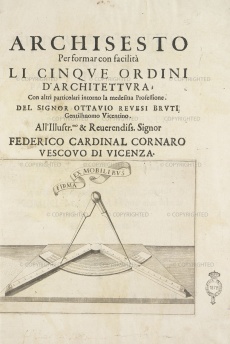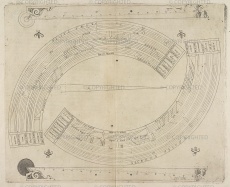"Archisesto" (Architectonic Sector)
From Inventions
| (9 intermediate revisions not shown) | |||
| Line 1: | Line 1: | ||
{{Template invention | {{Template invention | ||
| - | |nome= | + | |nome= Name coined by the inventor, combining the words "archi[tettura]" (architecture) and "sesto" (compass), i.e., 'architectonic compass'. |
| - | |descrizione= [[ | + | |descrizione= |
| + | [[Proportional Compasses | Proportional compasses]] for measuring the architectural orders according to the proportions of Andrea Palladio, invented by Ottavio Revese Bruti, an architect from Vicenza. Modelled after the geometric and military compass of Galileo Galilei, the instrument is formed of two flat legs and a transverse arc bearing five sets of proportional scales, each dedicated to one of the elements of an architectural order: the arches, architraves, columns, bases, capitals and balusters of the Tuscan, Doric, Ionian, Corinthian and Composite orders. The success of the archisesto among the proportional instruments used by architects was decreed by British authors who, between 1723 and 1761, at the height of the neo-Palladian vogue, published translations and revisions of Bruti’s treatise in honour of the special interest of King George III in architecture and mathematical instruments. In Britain the instrument was known as the [[Architectonic Sector |architectonic sector]]. | ||
| - | |inventore= Ottavio Revese Bruti ( | + | |inventore= Ottavio Revese Bruti (16th-17th cent.) |
|data= 1627 | |data= 1627 | ||
| Line 23: | Line 24: | ||
Wittkover, Rudolf. ''Palladio and English Palladianism''. Thames and Hudson, London, 1974.<br /> | Wittkover, Rudolf. ''Palladio and English Palladianism''. Thames and Hudson, London, 1974.<br /> | ||
| - | |strumentiesistenti= [http://emu.mhs.ox.ac.uk/Display.php?irn=1193 Oxford, Museum of the History of Science, inv. 55213.]<br /> | + | |strumentiesistenti= |
| + | - Museum of the History of Science, Oxford <br> | ||
| + | [http://emu.mhs.ox.ac.uk/Display.php?irn=1193 Oxford, Museum of the History of Science, inv. 55213.]<br /> | ||
[http://emu.mhs.ox.ac.uk/Display.php?irn=15806 Oxford, Museum of the History of Science, inv. 76416.]<br /> | [http://emu.mhs.ox.ac.uk/Display.php?irn=15806 Oxford, Museum of the History of Science, inv. 76416.]<br /> | ||
[http://emu.mhs.ox.ac.uk/Display.php?irn=1182 Oxford, Museum of the History of Science, inv. 40175.]<br /> | [http://emu.mhs.ox.ac.uk/Display.php?irn=1182 Oxford, Museum of the History of Science, inv. 40175.]<br /> | ||
| + | [http://emu.mhs.ox.ac.uk/Display.php?irn=15959&QueryPage Oxford, Museum of the History of Science, inv. 25362.]<br /> | ||
|link= | |link= | ||
| Line 31: | Line 35: | ||
|immagini= <gallery widths=230 heights=368 perrow=3> | |immagini= <gallery widths=230 heights=368 perrow=3> | ||
| - | Image: 923959_000010.jpg| Ottavio Revese Bruti, ''Archisesto'', Vicenza 1627, frontespizio.<br /> | + | Image: 923959_000010.jpg | Ottavio Revese Bruti, ''Archisesto'', Vicenza 1627, frontespizio.<br /> |
| - | Image: | + | Image: 923959_00018_00019.jpg | Ottavio Revese Bruti, ''Archisesto'', Vicenza 1627, p. X-XI.<br /> |
| - | + | ||
| - | + | ||
Current revision as of 11:03, 7 September 2010
Name coined by the inventor, combining the words "archi[tettura]" (architecture) and "sesto" (compass), i.e., 'architectonic compass'.
Contents |
Inventor
Ottavio Revese Bruti (16th-17th cent.)
Historic Period
1627
Description
Proportional compasses for measuring the architectural orders according to the proportions of Andrea Palladio, invented by Ottavio Revese Bruti, an architect from Vicenza. Modelled after the geometric and military compass of Galileo Galilei, the instrument is formed of two flat legs and a transverse arc bearing five sets of proportional scales, each dedicated to one of the elements of an architectural order: the arches, architraves, columns, bases, capitals and balusters of the Tuscan, Doric, Ionian, Corinthian and Composite orders. The success of the archisesto among the proportional instruments used by architects was decreed by British authors who, between 1723 and 1761, at the height of the neo-Palladian vogue, published translations and revisions of Bruti’s treatise in honour of the special interest of King George III in architecture and mathematical instruments. In Britain the instrument was known as the architectonic sector.
Bibliographical Resources
Johnston, Stephen. Science, satire and the architectonic sector. XXV Symposium of the Scientific Instrument Commission, Krakow 2006.
Kirby, Joshua. The Description and Use of a New Instrument called an Architectonic Sector.... London, 1761.
Malie, Thomas. A New and Accurate Method of Delineating all the Parts of the Different Orders in Architecture. London, 1737.
Revese Bruti, Ottavio. Archisesto per formar con facilita li cinque ordini d'architettura; con altri particolari intorno la medesima professione. Vicenza, 1627.
Wittkover, Rudolf. Palladio and English Palladianism. Thames and Hudson, London, 1974.
Existing Instruments
- Museum of the History of Science, Oxford
Oxford, Museum of the History of Science, inv. 55213.
Oxford, Museum of the History of Science, inv. 76416.
Oxford, Museum of the History of Science, inv. 40175.
Oxford, Museum of the History of Science, inv. 25362.
Images
Author of the entry: Filippo Camerota


